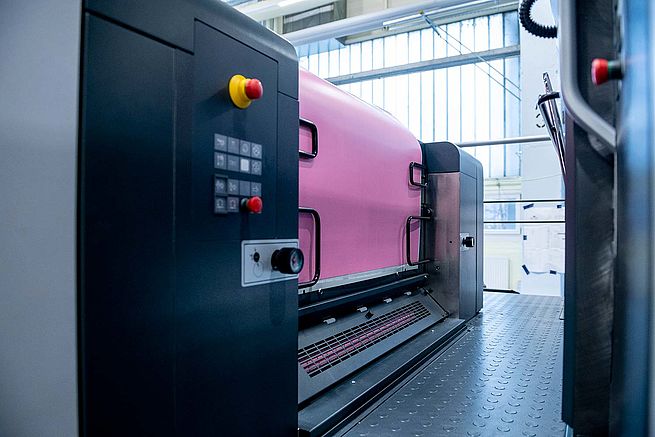- Numerous functions for even higher productivity and for autonomous processes
- Machine design: superior and visionary
- Plate logistics: from the platesetter directly to the changer without manual intervention
- World première: 20,000 sheets/hr in perfecting mode
- High-end quality control
- Smart operating concepts
- Comprehensive services for increased availability and enhanced performance
With the Rapida 106 X, Koenig & Bauer is unveiling a new high-performance sheetfed offset press for the medium format 740 × 1060mm. It meets every conceivable demand that today’s market makes of a press in terms of automation, digitisation and workflow solutions, thereby making it the latest in a line of trendsetting developments defining the future of industrial offset.
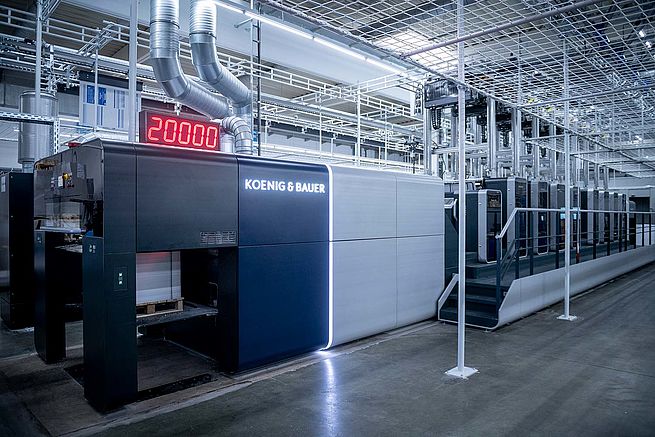
Superior, dynamic and of lasting value – these are properties that the Rapida 106 X embodies with its new award-winning design. Glass side panels, a new touchscreen operating concept and an expressive design language immediately identify the press as an ultra-modern automated printing system. What becomes evident with just a glance is that this is the most powerful Rapida that the market has ever seen.
The new Rapida 106 X series aims to lend performance a further boost in order to make companies even more profitable. There are five criteria that play an especially decisive role in this:
1. Shorter makeready times – faster into print
To avoid wasting even a second during makeready, the Rapida 106 X incorporates a host of pioneering and precisely coordinated features. These range from simultaneous plate changing in less than a minute with unbent and process-free plates to a multitude of parallel makeready processes, and also includes autonomous printing of a whole sequence of jobs with automatic activation of the good-sheet counter (AutoRun). At this level of automation, the Rapida 106 X is truly a perfect automatic printing system.
As soon as the sheet counter reaches the specified run length for the current job, the impression is thrown off and the Rapida 106 X automatically begins the job changeover. Once makeready is completed, printing resumes for the next job without any intervention by the operator. The measuring and control systems detect when the specified print quality has been attained and re-activate the sheet counter. After printing the required number of sheets for the second job, the press switches back into job changeover mode. This process is then repeated as often as is necessary to complete the whole sequence of jobs.
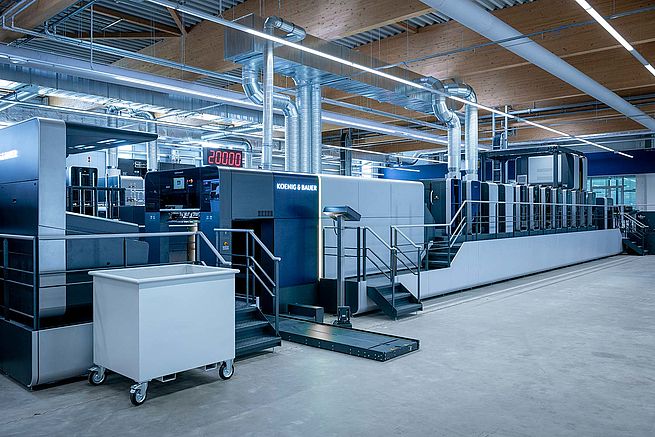
Plate logistics right up to the printing unit
A similarly high level of automation characterises the new PlateTronic plate logistics system. It can be incorporated into the new Rapida 106 X upon request. It has been designed as a modular system and exhibits the versatility to adapt to the requirements of each individual print company.
From job preparation in the PPS system LogoTronic Professional to plate exposure and delivery up to the designated printing units on the press, as well as the removal of the old plates, the process is completed without any manual intervention whatsoever. Assignment of the plates to the individual printing units is managed by the logistics system, meaning that the order in which the plates actually reach the press can be varied as required. The Koenig & Bauer logistics system guides the plates directly into the plate changers. The operator’s work consists solely of process monitoring.
At commercial printing companies with short runs and frequent language or section changes in particular, the plate logistics system offers key benefits in terms of productivity. Imagine printing a job with a run length of around 350 sheets requiring removal of the old plates from eight or more changers, and loading of the same number of new plates ready for subsequent mounting, all while the job is proceeding – an operator could only keep pace with the press for a short time. The technology provides a distinct advantage in this case, and helps to ensure that the Rapida 106 X is always back in production as quickly as possible.
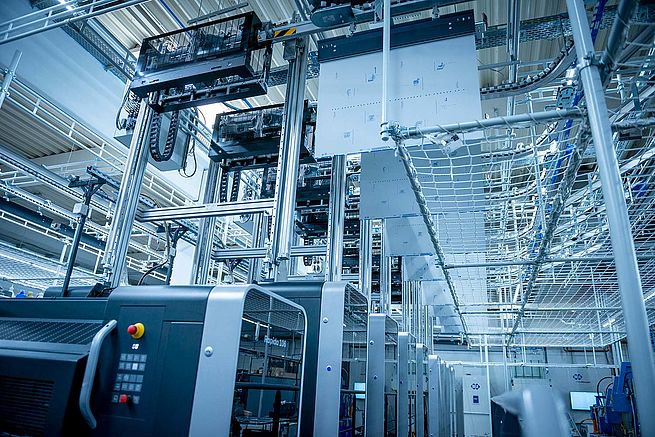
2. Higher speed – even faster in production
As a world first, the Rapida 106 X reaches production speeds of up to 20,000 sheets per hour in perfecting mode. It thereby opens the door to entirely new levels of performance for perfector presses. Commercial printers that use eight-colour presses for 4-over-4 production will be delighted, as they now have access to the same high-performance technology as companies working with straight presses only.
Optimising job sequences offers additional potential for raising the daily output of sheetfed offset presses. With this in mind, Koenig & Bauer is launching a brand new tool together with the Rapida 106 X: the Job Optimizer. This tool acts as a link between MIS and PPS, and optimises the order of the jobs preset in the MIS scheduling module in accordance with technological or press-related considerations. The former include aspects such as the sheet format, substrate weight, type of coating and quality levels of complex formes. Examples for the latter are the option of implementing parallel processes, or formes that are suitable for use of the print-clean function rather than resorting to more time-consuming washing processes. An optimised job sequence can shorten makeready times by a further 30 to 50 per cent, depending on the parameters of the specific job.
Information on compliance with OEE criteria, used for overall equipment efficiency, is provided by the new LogoTronic Cockpit. Just-in-time analyses are performed on all production data and times, and the results are presented in clearly structured diagrams. It is possible to compare the current production performance and makeready times with reference settings at just a glance. At the same time, production data can be used in costing analyses to enable comparisons with the planned values. Profits and losses are quantified in real time.
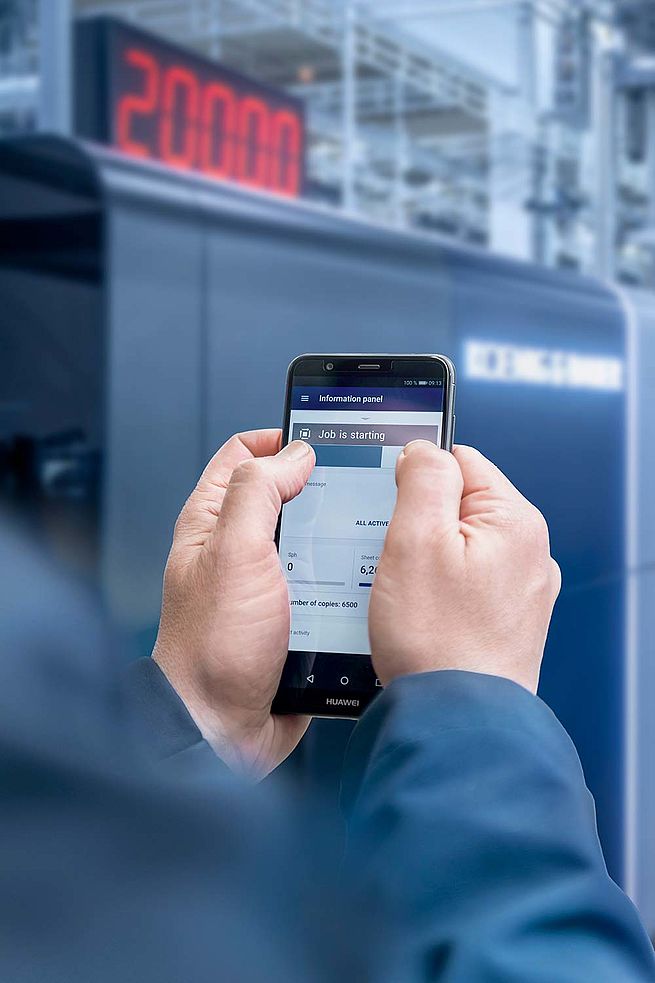
3. Reliable processes – stable in production
When it comes to measuring systems, too, Koenig & Bauer has set the benchmark. A single camera system (with two cameras on perfector presses) covers three functions: inline colour control, sheet inspection with continuous production monitoring, and comparison of the printed sheets with the pre-press PDF.
QualiTronic ColorControl measures the ink densities in colour bars on every single sheet. The system uses the measured values to calculate corrections to the ink settings every ten sheets. In conjunction with the fast reaction by inking unit of the Rapida 106 X, jobs are brought into colour in next to no time – the number of waste sheets at start-up and after production stoppages decreases tangibly: just 25 to 50 sheets, depending on the job and quality parameters.
QualiTronic PrintCheck upgrades inline colour control by adding a production monitoring function. When printing starts, the system scans a set number of good sheets to generate a reference. All printed sheets are subsequently compared with this reference. Any deviations that are detected are displayed on the monitor and can also be marked in the pile by using an optional tag inserter. All these processes require no makeready and run fully autonomously.
A comparison of the printed sheet with a customer PDF is performed using QualiTronic PDFCheck. This system allows flaws to be detected before the actual production run even commences – a major bonus, especially for Internet or packaging printers. The PDF comparison is performed for every single sheet during production, at a scan resolution of 100dpi. If the system spots any differences between print and PDF, the operator is alerted and is prompted to intervene. A report is created to document the print quality.
QualiTronic PDF HighRes conducts sheet inspection with even greater precision. The content of each printed sheet is checked at a resolution of 290dpi. Even the tiniest flaws and deviations as minute as approx. 90µm can be detected, visualised and logged. To this end, two additional cameras are installed on the Rapida 106 X.
Smart tools for intuitive processes
Once the colour is within the specified tolerances, the Traffic Light function provides information about the overall quality of the production. Three different quality levels can be defined. If a green light is displayed, the quality meets the specifications and the good-sheet counter is activated automatically. Traffic Light allows waste to be reduced while printing in a defined, comparable quality and maintaining effective control over the whole length of a run.
Koenig & Bauer is offering a pair of smart tools for the print process in the form of the Rapida LiveApps. ErgoTronicApp allows the entire press to be visualised on a mobile device. Printers can view all job data for the current and next job, production times, notifications and maintenance instructions, including support, to enable them to carry out the work. This makes the press console mobile. The ProductionApp can be used to manage store inventories, track consumables batches and much more. The app provides an accurate overview of which print jobs were produced with which batches of substrates, inks and consumables, even after the job is finished.

4. Less maintenance – more time in production
Data-driven services and digital business processes lay the foundations for optimised maintenance processes for sheetfed offset presses from Koenig & Bauer. Most of the customer-oriented services are based on performance data from the presses and their log files.
PressCall improves communication with the remote maintenance service and optimises communication by eliminating language barriers. Visual PressSupport increases the scope of services that can be provided by remote maintenance by enabling direct insight into the press using the operator’s smartphone. Photos, videos, audio and a comment function help provide a much clearer description of the situation that results in a remote maintenance call, and also make it easier to provide assistance in relation to process technologies or mechanical press components.
A monthly performance report shows performance data and key performance indicators of presses in an easy-to-understand graphic form. In addition, performance data can be compared internally and externally with those from presses used in a similar manner – anonymously, of course.
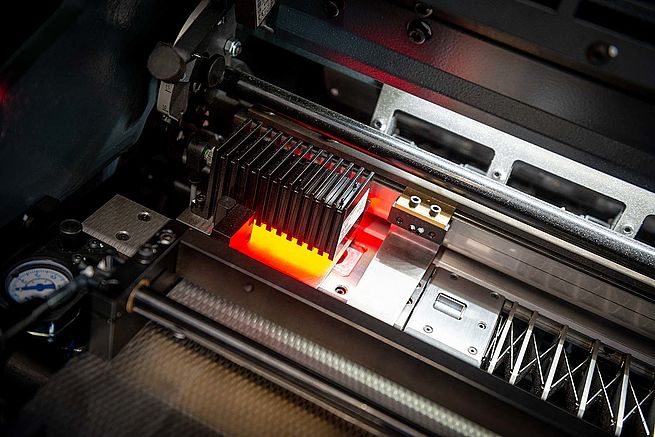
5. Digitalization – top in profitability
Thanks to artificial intelligence and by making use of sensor data from the presses, a steady stream of features has been, and continues to be, developed to ensure the Rapida 106 X operates with ultimate productivity, to increase its production availability and to promote a detailed exchange of information between users and the manufacturer using digital channels. What we call our Customer Community is the central point of contact. This is where new tickets can be created, open tickets and performance reports can be viewed, and a range of other digital services can be accessed. Users and the manufacturer can access an identical information database, meaning that they are all on the same page when working together. In future, the Customer Community will unite all digital services under one and the same roof.
Sensor data from the press are becoming increasingly important as a means of localising faults before they result in actual press downtime. Using methods incorporating artificial intelligence, it is possible to analyse sensor responses to distinguish between normal and abnormal press behaviour. As soon as abnormalities are detected, bots intervene in operations and automatically generate a service ticket. The service engineer responsible then takes a defined series of measures and, if necessary, contacts the user without delay to discuss scheduled maintenance and avert any unplanned downtime.
LogoTronic now features a new and versatile, operating and press data-based reporting tool, the Performance Analytics Plus option, which will be able to be accessed by means of the Customer Community in future. Performance Analytics Plus enables print companies to analyse processes from different perspectives in order to maximise the performance of their Rapida technology. Job histories, production time records and much more can be visualised ad-hoc in configurable dashboards that adapt to individual requirements. Even complex trend analyses that allow the user’s own long-term strategies to be monitored can be generated with just a few clicks.
All these details add up to make the Rapida 106 X the most powerful and most efficient medium-format Rapida that the market has ever seen.
